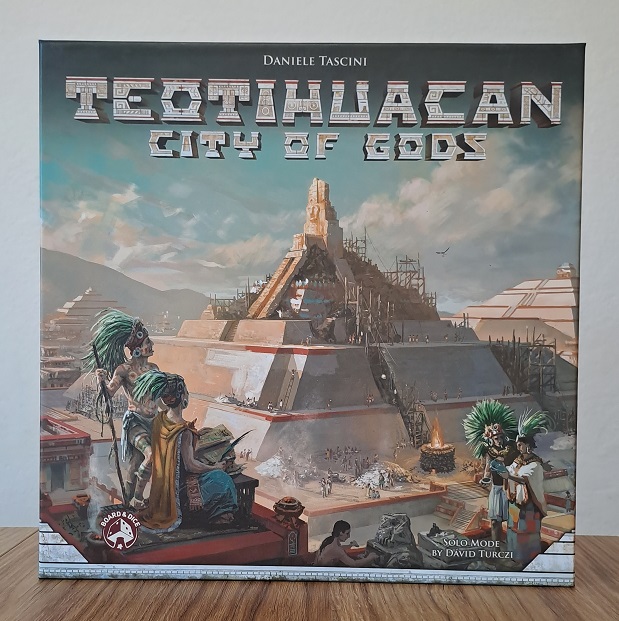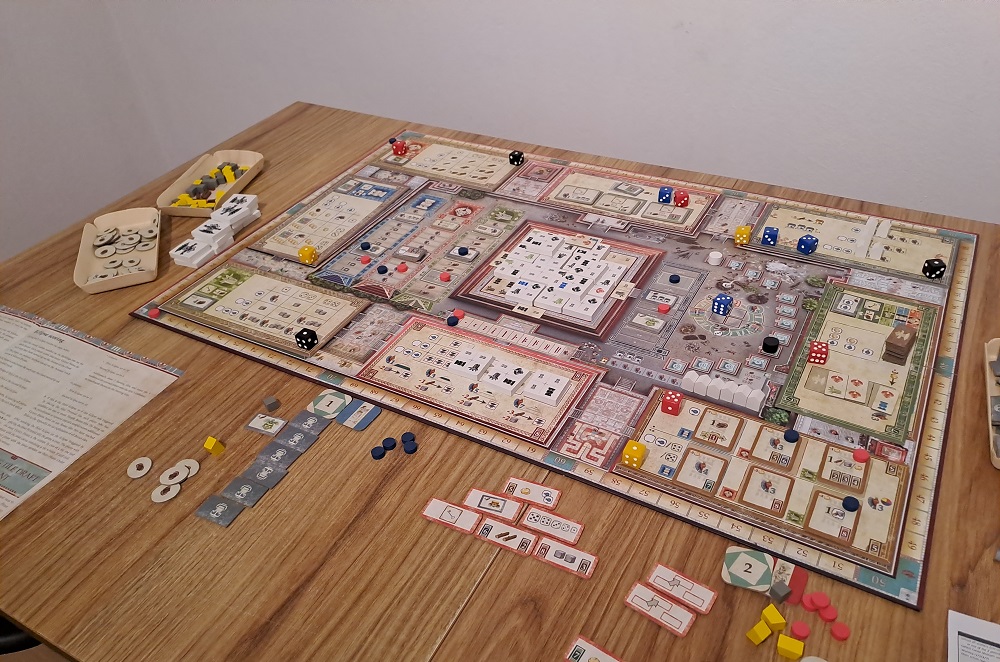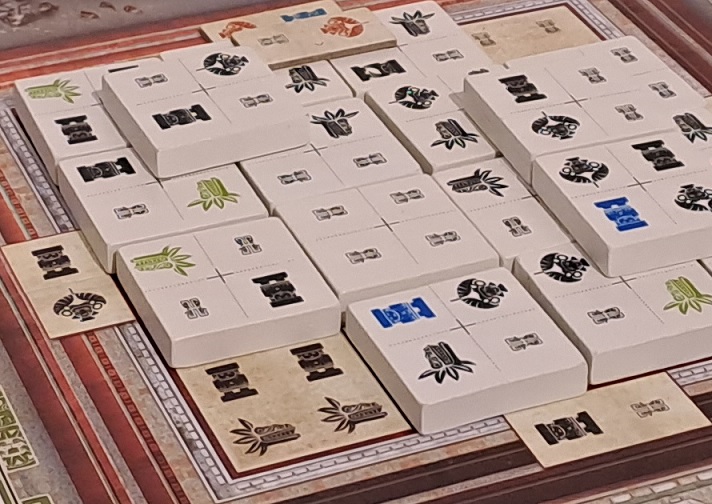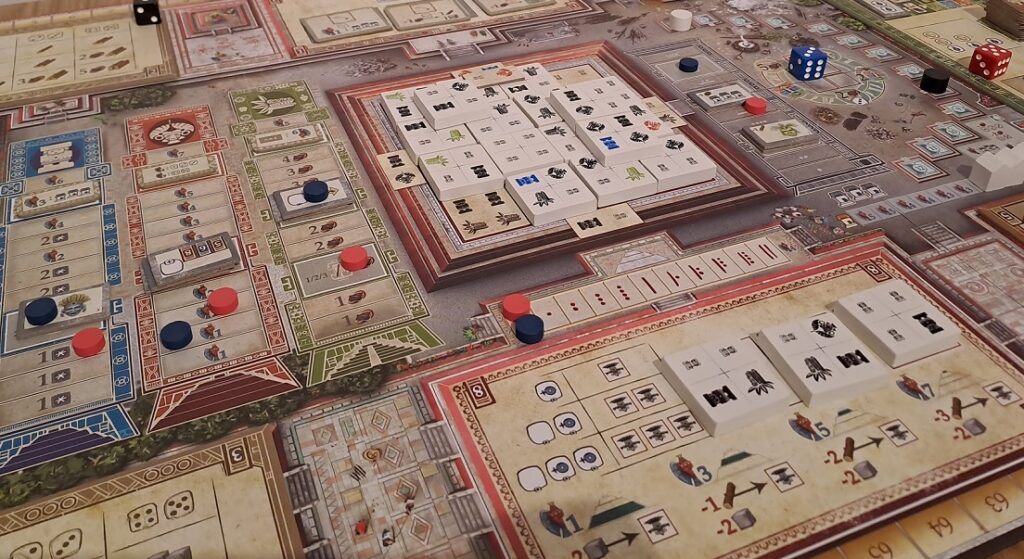In this review, read about the ins and outs of Teotihuacan, an advanced resource management and dice placement board game. Is it still relevant?
Introduction to Teotihuacan Board Game Review
If you’re not new to board gaming, you’ve probably heard about the family of T-games, a series of heavier resource management games from Board & Dice that usually use dice in clever ways. As a relative latecomer to the modern hobby, I’ve had the luxury to explore the games at my own pace.
Although I liked Tabannusi, it didn’t exactly blow me away (you can read my thoughts in the Tabannusi review). So, the obvious choice for T-games to impress me, was Teotihuacan, the most well-known and most highly-regarded of the bunch. It has been on my wishlist for a while and when an opportunity presented itself on the second-hand market, I didn’t hesitate.
The object of this rather late review, besides providing a general overview of the game mechanics, theme, and components, is to see how well Teotihuacan stood the test of time and if it’s better than Tabannusi. And of course, did it blow me away?
Teotihuacan: City of Gods Facts

Published: 2018
Designer: Daniele Tascini
Artist: Odysseas Stamoglu
Players: 1-4
Playing time: 90-120 minutes
Complexity: medium-heavy
Game Concept
Teotihuacan could be best described as a dice-placement resource management game. The dice, representing your workers and their strength are moved clockwise among several locations that allow you to collect resources and then spend those resources by contributing to the construction of the Pyramid of the Sun, the Avenue of the Dead, and climbing several temples.
The game is played for several rounds (or until the pyramid is completed) and the points are then summed up.
While the idea is simple, there are many nuances that complicate matters, particularly the fact that the more workers you have at a location, the more powerful your action is. Therefore, the game boils down to a big optimization puzzle, as you’re trying to coordinate your movements and worker placements.
The Looks
The theme is rather abstracted in Teotihuacan. Yes, there are some connections between game mechanics and thematic concepts (i.e. worker ascension), but it’s not really felt during the gameplay. You could easily repaint the whole game into something else.
The artwork, on the other hand, is appropriate, has a recognizable mesoamerican tone, and uses light tones as the main component color. The whole graphical design makes the board almost clinically transparent and easy to read, and the iconography is consistent across the board and intuitive.
The components are solid, as well – an excellent combination of wood and cardboard. A particular standout for me is the pyramid building blocks.
The board itself takes a good chunk of table space, but I do like that the large majority of game components are on that board. There are no secondary or player boards. This concentrates all the action and player attention on that central board.

Ripping out the Heart of the Game
As already mentioned, Teotihuacan is not a light game by any stretch of the imagination. This becomes apparent as soon as you take the rulebook into your hands and try to set up a game. The rulebook is actually quite well-written, structured, and easy to understand. But still, you’ll need to really sink your teeth into it to learn the game.
The same is true for the lengthy setup. There are many tokens and tiles to place on the board so it does take a while to get everything up and running. The components also offer plenty of set-up randomization, so that you can’t open every game the same way. Luckily, there’s also a first-time setup guide, for those first couple of games when you want to keep things straightforward.
Turn structure
On their turn, a player will choose one of their dice workers and move 1-3 spaces clockwise. On the arrival space, they can choose to perform the main action, collect cocoa, or worship. We should probably talk about cocoa first, which is a currency that players use for main actions.
In order to perform a main action, you must first pay a cocoa amount equal to the number of different colored dice on that action space. Conversely, you can choose to collect cocoa, which means this is all you do that turn, but you collect a cocoa amount equal to the number of different colored dice on that action space +1.
This concept serves an interesting and challenging dynamic to players, as you always need to have enough cocoa to perform actions in occupied spaces. Therefore, players will seek opportunities in vacant action spaces and use crowded spaces to collect cocoa.
But beware, as collecting cocoa does not contribute to winning the game directly and can be regarded as a “dead” action. There are other ways of acquiring cocoa, through main actions, technologies, and temples. But these require a lot of coordination to work, making cocoa management one of the pivoting points in Teotihuacan’s strategy.
Before we move on to the main actions, let’s quickly mention the alternative worship action. These are powerful, but very situational actions that are available in some action spaces. They let you advance on one of the three temples directly, plus you can acquire a discovery tile. Downside? They lock the dice in that space, meaning you have to pay cocoa to get them out. But used at the right time, they can be useful.
Temples offer many awards on the steps toward the top: resources, points, and cocoa. Reaching the top also qualifies you for an end-game scoring criteria, which can net a nice amount of points. Discovery tiles are one-time abilities, that you can use at any time and can offer useful boosts.
Main Actions
Main actions can be roughly divided into two categories:
- Those that allow you to collect resources.
- Those that allow you to spend them.
Three action spaces fall into the first category: wood, stone, and gold. The more workers you have and the higher the pips on your lowest die, the more resources you get, which is depicted in a useful table at every one of these spaces.
The second category of actions is: building a pyramid, decorating a pyramid, building houses, and acquiring technologies.
At these spaces, the pips are not important (making them ideal to level up your dice) and these are the main source of points during the game. On the pyramid, you can score extra points if you match the icons, while the houses move you further on the Avenue of the Dead, producing points at every eclipse (round scoring). Having more than one worker in an action space helps with the efficiency, quantity, or scoring potential of the action.
Technologies are not to be neglected as they provide constant bonuses in the form of discounts, extra resources, or extra points when you perform certain actions.

Ascension
After every main action, you can level up your worker(s). When the die would reach 6, it ascends and is reborn as a 1. This grants you a free advance on the Avenue of the Dead, as well as an ascension bonus of your choice. The downside is that you lose your high-level worker and that the game timer moves one turn, making the game one turn shorter with each ascension.
The ascension mechanic provides an interesting dilemma for players. On one hand, you want to power up a worker quickly to reap the ascension rewards, on the other hand, you want to keep your high-pip workers alive so that your actions are stronger.
When collecting ascension rewards, you ideally want to pick the one that allows you to advance on two temples by one or on one temple by two steps. This is a significant bonus, but it does come with a drawback – you need to pay 3 cocoa for it. If you don’t have this cocoa, you can always pick a lesser reward, in the worst-case scenario, you can just take 5 cocoa instead.
This brings us back to the importance of cocoa management. Now you’re spending an ascension to get cocoa when you could be advancing on the temples and getting back some of that cocoa on the green temple instead. So you need to time your ascension, as well.
Beware of the Eclipse
The game is hard-capped by the number of turns depending on the player count, and, as said, this can be further reduced by the number of ascensions the players achieve during the game.
In addition to the final scoring, there are two partial scorings during the game, which are thematically depicted by the black and white markers, which initiate an eclipse as they converge ever closer with each passing turn and ascension.
Digesting the Heart of the Game
Generally, there are two ways to score big points during the game, the pyramid and the Avenue of the Dead, and you’ll have to do both to be competitive.
But that doesn’t mean that every game will play out the same. A lot depends on the starting resources, which will push in a certain direction. If you start with gold, you’ll probably want to claim a few technologies early on, likely those that will make your future actions more profitable, points and resource-wise.
But if a matching decorating tile is available, you might want to spend your gold there, and here’s why. When contributing to a pyramid (adding blocks or decorating it), the symbols are important. You receive an extra point for each matching symbol. Moreover, if the matching symbol is of color, you also get to advance on the corresponding temple.
If you stack this with a technology bonus that gives extra points for building a pyramid, a technology bonus that gives you a resource discount when building a pyramid, and add more than one worker dice, then you’re starting to get somewhere. It’s combos like this that are the bread and butter of Teotihuacan. Hard to set up, but extremely satisfying to accomplish.
It’s true that planning these monster turns can lead to analysis paralysis and that the turns can sometimes take a while (especially if the players don’t plan ahead when choosing a pyramid block), but Teotihuacan is a gamer’s game, not a game for a casual get-together. Therefore you need a certain group of players for this and only you know if you have one.
The replayability of Teotihuacan mainly comes from the optimization puzzle. Rarely will you feel as if you have done everything right and you will want to play again and improve. The high setup randomization makes your job difficult, ensuring there are no exact opening strategies that would work every game. You have to adapt to what is presented to you and what tools you’re given to work with.
Have I mentioned that you have to pay salaries to your workers at every eclipse? They’ll take it in cocoa, thank you very much. 1 per worker. Oh, and your 4 and 5 dice will take one more cocoa, please.
This creates extra tension as you watch the eclipse markers move closer and closer. You need to calculate which worker to power up, and how many turns you’ve got left to climb the necessary tracks and collect enough cocoa. I’ll give you a hint: there are never enough turns to do everything.

Player Interaction and Scalability
In addition to competing for pyramid tiles, houses, discovery tiles, and climbing the tracks, the most interesting player interaction element is with the aforementioned cocoa management. Since you have to pay cocoa for every different colored dice (including your own) when performing a main action, it’s very important where players place their dice and when.
For example, you’ll often consider taking a main action just because it’s cheap or you’ll have to make a hard decision if it’s really worth paying 4 cocoa to perform a main action. Perhaps you’ll use that crowd to collect cocoa and then move in with another one of your workers later to perform the main action with greater effect.
Blocking is another useful strategy. If you know other players will build a pyramid, you might want to leave a worker there. While you can’t prevent them from moving in, at least the action will be more expensive for them.
All this interaction suggests that Teotihuacan is best experienced at the full player count of 4. While this is true, it does work surprisingly well with fewer players, as there are dummy dice placed at action spaces to simulate the presence of other players.
A special mention must go the solo mode against Teotibot. The mode is designed by the renowned David Turczi and it simulates a real player quite elegantly, while the upkeep is not too bad either. Relatively speaking of course. Don’t forget, this is still a heavy game and the solo mode is another layer of rules you have to learn.
Conclusion
Teotihuacan is an exceptional board game. But it’s a bit of a slow burner. It does take a while to learn the game before you can start appreciating the brilliant optimization puzzle. I have to admit I did help myself learn the game with the great adaptation over at Board Game Arena. But once the ice was broken and the game opened up, I was blown away.
Although I have only scratched the surface with the “T-games” series, I can say Teotihuacan is clearly a better game than Tabannusi, Origins, and probably also Tzolk’in (although I haven’t played the latter enough to be able to fully judge).
But I can’t recommend this to everyone. Teotihuacan is a heavy game, so you and your group must be prepared for this one. Don’t have a group of heavy gamers? No problem, because the solo mode is great and easily worthy for solo-only purchase – if you’re into meatier solo experiences.
This one is definitely staying in my collection and it already makes me curious about all the available expansions and the other T-games, such as Tawantinsuyu and Tekhenu.
Teotihuacan is available on Amazon (US) and Philibertnet (EU)
Read heavier games reviews on Victory Conditions:
- Gaia Project Board Game Review
- A Feast for Odin in 2022 – Review
- Praga Caput Regni Board Game Review – Glorius Capital of the Holy Roman Empire
If you click on an affiliate link, it will take you to the Amazon store. If you then buy something, I will earn a commission – I am a member of the Amazon Associates program, as well as others.
